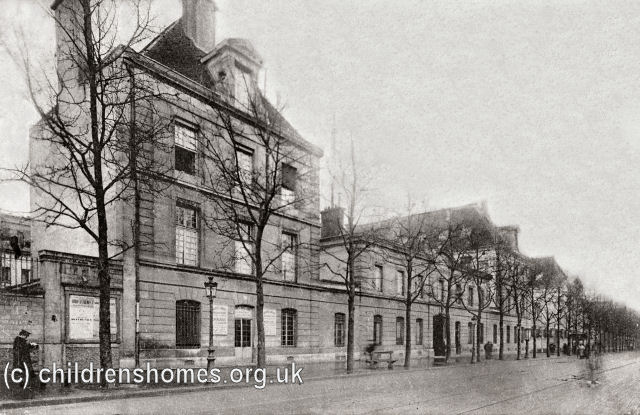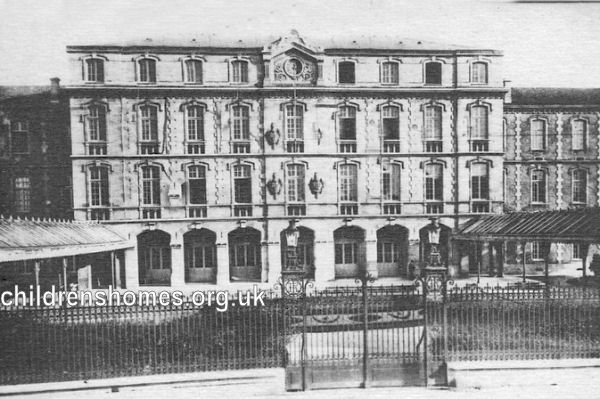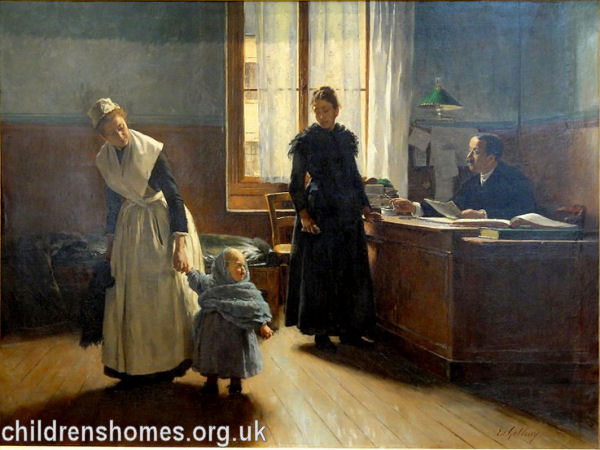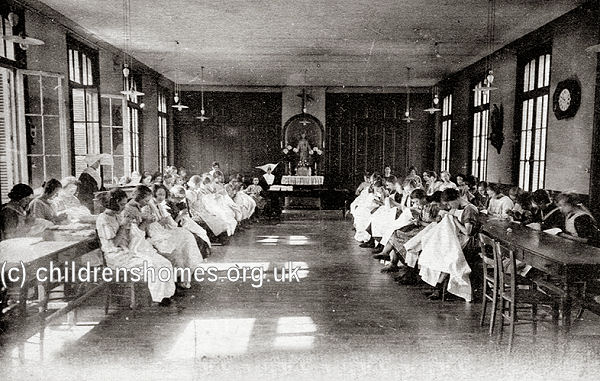Children's Homes and Institutions in France
An early refuge or hôpital for the sick and for foundlings was founded by Frère Guy, of the les Frères du Saint Esprit (Brothers of the Holy Spirit), at Montpellier in 1180. Unwanted babies could be anonymously deposited in an early version of what became known as a tour — a revolving cradle in its wall. The infants were then placed with wet nurses or foster families until returning the institution at around the age of three, where they remained until the age at which they could earn their own living. A similar establishment was founded by the order at Marseilles in 1158, with their example soon followed at Aix and Toulon. In 1362, a brotherhood was created in Paris for the benefit of neglected children, and the Hôpital du Saint Esprit opened for their reception. The Hôtel Dieu, at Lyons, was opened for the same purpose in 1523.
Another Paris establishment, which became known as La Couche, was founded in 1530, settling in 1570 in premises close to Notre Dame cathedral. In 1638, the Sisters of St Vincent de Paul (also known as the Daughters of Charity) became involved in the running of the Couche and grew to become the major operator of children's homes in the city and in France as a whole. Paris's provision for foundlings, which adopted the name L'Hôpital des Enfants Trouvês, was taken advantage of by towns elsewhere in the country and suffered from severe overcrowding and a high mortality rate.

Foundlings and their nurses, Paris, date unknown.
Prior to the French Revolution (1789-99), there was no support by the state for foundlings or orphans, it came from local nobility, communities of inhabitants and, above all, religious institutions. Following the Revolution, the principle was adopted that all abandoned or orphan children should be the responsibility of the state, whose duty was to ensure that they became healthy and useful citizens, for example by training them for military or agricultural employment, or to work in the colonies. A law in 1811 required each Prefecture to provide a facility to deal with abandoned and found children. All the hospitals and hospices in France were required to take in such children, with the cost of their maintenance now coming from the public purse. All 'hospitals' that received abandoned children were thereafter to be called 'hospices'. Free maternity hospices were set up across the country where mothers, after giving birth, could surrender (or 'abandon') their child to the state. Each hospice was also to be equipped with a tour.

A tour from Marseille
The children were now placed in one of three categories:
- Foundlings (Enfants Trouvés) — children belonging to unknown parents, found exposed in any situation whatever, or left at the hospices opened for their reception. A register was kept to record their sex, age, and any identifying marks.
- Abandoned Children(Enfants Abandonnés) — the offspring of parents who were known, and who had been cared for by such parents or others until a certain age, then left, without it being known where such parents or guardians resided.
- Destitute Orphans (Enfants Orphelins Pauvres) — those who have neither father nor mother, nor means of subsistence.
Children were usually placed out to nurse until the age of six, then placed in the families of farmers and mechanics. The payment given for maintaining each child reduced each year until the age of twelve, at which age all males were placed at the disposal of the Minister of Marine. Children who could not be placed, due to lameness or infirmity, were reared at the hospice and placed in the workshops, at labour suitable to their age. Children not then taken into state employment were apprenticed, as far as possible, boys with farmers and mechanics, girls with families, work-women, or in workshops and manufactories.
By the middle of the nineteenth century, the policy established after the Revolution had resulted in parents in France abandoning their children in huge numbers — up to 20 per cent of live births in the Paris area. The abolition of the tour in the 1860 had some impact on this figure but much more significant was the steady improvement in economic conditions towards the end of the nineteenth century which improved parents' ability to keep and support their offspring.

Hospice de Enfants Assistés, Bordeaux, c.1900.
From 1859 to 1904, foundlings, abandoned and orphaned children were officially referred to as 'enfants assistés', while a separate category of 'enfants moralement abandonnés' (morally abandoned children) was created in 1881. An update to the official framework in 1904 distinguished the categories of:
- Rescued Children (Enfants Secourus) — children raised by their mother or placed by a mother with a nurse, and receiving temporary help, i.e. financial assistance
- Children on Deposit (Enfants en Dépôt) — Children received temporarily following hospitalization or detention of their parents
- Foundlings (Enfants Trouvés) — children born to unknown fathers and mothers who were found at the door of a hospice or some other place.
- Abandoned Children(Enfants Abandonnés) — children born to known parents — or at least the mother - raised, at first, by them and then abandoned or given up by them.
- Destitute Orphans (Enfants Orphelins Pauvres) — those having neither father nor mother, and no means of support.
- Morally Abandoned Children (Enfants Moralement Abandonnés) — initially, these had been children from 12 to 16 years old living without shelter and without help. It had been extended to include children whose parents who had lost their parental authority or from whom it had been removed.

Edouard Gelhay's 1886 study of a mother 'abandoning' her child at a Hospice des Enfants Assistés.
The first two categories (rescued children and children on deposit) were designated as children placed under public protection; the others (foundlings and abandoned children, poor orphans, and morally abandoned children) referred to a Wards of the State (Pupilles de l'État) or Wards of the Public Assistance (Pupilles de l'Assistance).
Apart from public provision for unwanted children during this period, there was a major growth in during the nineteenth century in the number of charitable establishments for orphans and other children lacking a family, most of which were mostly run by the country's hundreds of religious orders. These groups also ran a variety of other institutions to support children and young people, such as ouvroirs or workshops, where girls were employed in sewing in return for their accommodation.

Ouvroir of Sisters of St Vincent de Paul Orphanage, Le Havre, c.1900.
In 1956, Public Assistance was renamed Child Welfare, initialy the responsibility of Health and Social Affairs Directorates, now Departmental councils.
You can view brief information on over 2,300 establishments in France run for children and young people, covering the period up until the First World War. The list is ordered by French Department name (as defined prior to 1957 when some reorganisation took place). Click on the required entry below to see the entries for each Department (or use 'List by Location' on the menu bar at the left side of the screen). Paris is included in the Department of Seine.
Bibliography
- Dinan, Susan E. Women and Poor Relief in Seventeenth-Century France: The Early History of the Daughters of Charity (2017, Routledge)
- Fuchs, Rachel Abandoned Children: Foundlings and Child Welfare in Nineteenth-Century France (1984, State University of New York)
Links
- None identified at present.
Except where indicated, this page () © Peter Higginbotham. Contents may not be reproduced without permission.


